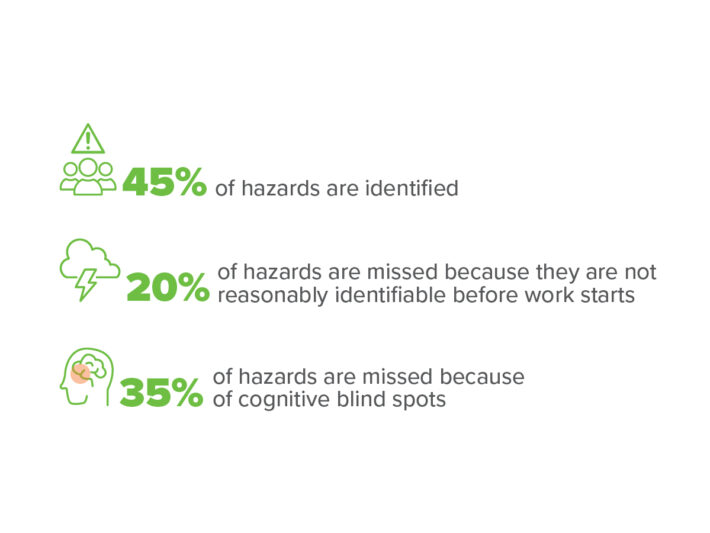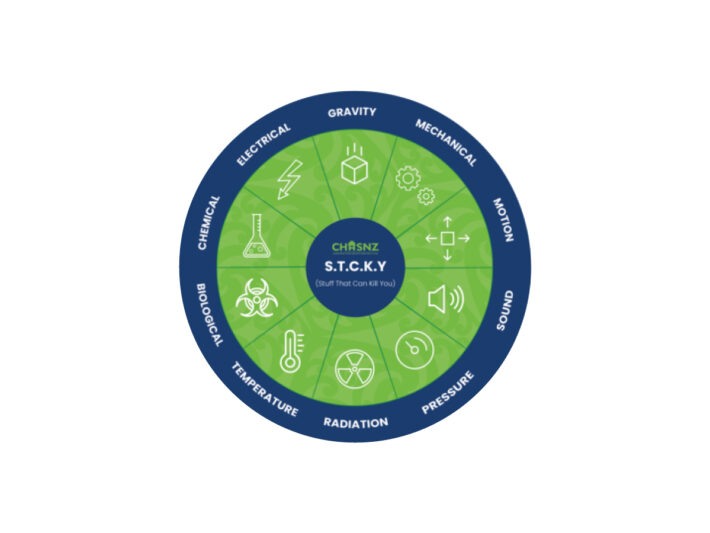Energy-based hazard recognition
25 Mar 2024, LBP & Regulation, Learn, Prove Your Know How

What if I said to you that people working on building sites up and down New Zealand are only able to identify up to 45% of the hazards that they are working amongst?
How about if I said that 35% of hazards are missed because of limitations in the way our brains process what we see, and 20% are missed because work is often unpredictable?
A recent US study measured hazard recognition in data collected from 4,800 worker-hours of field observations from 12 different construction trades and that’s exactly what they found.

Hazard recognition
Hazard recognition is vital for nearly every safety activity, including pre-task safety briefings, safety observations, risk assessments, and design reviews.
Most safety practices are built on the assumption that workers can see hazards that are there and can anticipate those that may arise from work.
In fact, inadequate hazard recognition appears as a contributory factor in around 50% of workplace incidents.
Because they appear so obvious after an event, people have often been wrongly blamed for being complacent or negligent.
Why some hazards are easy to identify while others are often overlooked
Let’s start with an example. There are 2 scenarios on the right hand page:
Scenario A
- An unprotected exposure to a fall hazard over 5m.
- An individual is placed at the edge and is asked to look down at the ground below.
Scenario B
- An unprotected exposure to a 3m deep, clear-cut excavation wall of sandy-clayey soil.
- An individual walks to the bottom of the excavation and is asked to reach out and touch the soil wall opposite the roller.
In scenario A, nearly anyone would identify that they are in a dangerous situation, and many would experience fear, anxiety, elevated heart rate, weakness in the legs, or even feel sick.
In scenario B, although the scenario is potentially fatal if the soil wall were to collapse, an individual may fail to understand the seriousness of the hazard.
Even well-trained workers are unlikely to experience the same intense emotional and physiological response as in Scenario A.
So why do we tend to have a physiological and emotional response to one but not the other?
The answer lies with our brain and how it processes information.
When we look at hazards that involve energy, such as gravity or motion, the instinctive part of our brain fires up.
That’s because human brains have evolved short cuts over very long periods of time to quickly recognise things in our environment that are a potential danger to us.
That same part of our brain also is responsible for our ‘fight or flight response’, which is why when we instinctively see such hazards, we tend to feel something.
Alternatively, hazards that are most commonly missed (eg, mechanical, pressure, chemical, biological) are processed in more advanced locations of the brain and require much greater effort to process the information.
What can we do about it?
As every injury is the result of the unwanted release of, and contact with, 1 or more energy sources, we can use energy categories to prompt our thinking.
To do this, we use the energy wheel: Each of the 10 icons in the energy wheel represent a different type of energy. See page 18.
Although not strictly scientific, the icons represent the most common ways that energy is present at work.
Examples of energy Hazards
Gravity: Force caused by the attraction of all masses to the mass of the earth.
- Uneven work surface
- Work at height
- Unsecure materials
Motion: Change in position of objects or substances.
- Traffic
- Mobile equipment
- Projectiles
Mechanical: Rotation, vibration, tension, or compression.
- Augers
- Cables
- Grinder wheels
Electrical: The presence of an electrical charge or current.
- Wires
- Power lines
- Power tools
Pressure: Liquid or gas compressed or under a vacuum.
- Vehicle tyres
- Piping systems
- Hydraulic lines
Sound: Audible vibrations caused from the contact of 2 or more objects.
- Heavy machinery
- Power tools
- Nail guns
Radiation: Elements that emit ions or atomic particles.
- Welding
- Sun exposure
- X-ray testing
Biological: Living organisms that pose health or safety risks.
- Bites and stings from animals
- People (violence or aggression)
- Toilets
Chemical: Reactive elements in the environment.
- Cleaning products.
- Engine exhaust
- Silica dust
Temperature: Differences in thermal energy with the human body.
- Friction
- Engines
- Steam
How do I use the energy wheel?
You can use this simple 2 step process:
- To start, put the energy wheel away and recognize hazards using your instinct.
- Then go around the energy wheel to see if you missed any hazards.
Points to note:
- The energy wheel helps us to do what we already do better.
- Do not identify hazards then try to classify them.
- The name of an energy source (eg gravity) is not a hazard.
- The energy wheel adds structure and strategy to pre-job safety briefs.
- The energy wheel can help
- provide clearer understanding of hazards and when change is a factor.
- The energy wheel can support meaningful conversations and the sharing of knowledge experienced people gain over time, that isn’t normally written down.
Further information
Construction Health and Safety New Zealand (CHASNZ) is an industry-led charitable trust working to improve the lives of construction workers by raising the standard of health, safety, and wellbeing in construction.
Energy wheel resources can be found on the CHASNZ website. The source material for this article has been developed by our friends at the Construction Safety Research Alliance, Colorado USA.

This article is an excerpt from Codewords Issue 117 and has been published verbatim. As such, neither PlaceMakers nor Under Construction magazine’s publishers take responsibility for the accuracy of the article or its corresponding questions.
Reading Codewords articles that are relevant to your licence class is a mandatory requirement for Licensed Building Practitioners. These questions can be answered through the LBP portal, online on the Under Construction website or recorded on the magazine, then provided at the time of renewal.
Register to earn LBP Points Sign in
7 Comments
Leave a Reply
You must be logged in to post a comment.




ENERGY-BASED HAZARD RECOGNITION is a highly useful approach that helps us better identify and manage potential hazards in the workplace. By focusing on energy release, we can consider various potential sources of danger comprehensively and take appropriate measures to mitigate the risk of accidents. This method allows us to systematically examine the work environment and propose effective solutions to ensure the safety and health of employees.
Very interesting information
cool
Well done
1
great
Good